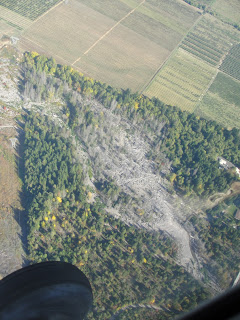Tim spent about fifteen years restoring an historic aircraft called the Arctic Tern which he now flies for pleasure. That airplane was used in the 1950's by an explorer of the northern polar regions. Tim did extensive amounts of research while he was restoring the plane, collected the books written about the explorer and his adventures in the plane, and eventually had the privilege of meeting the man who flew the plane over the arctic circle.
It has been many years since I have flown with my little brother. Yesterday, for my birthday he took me on an aerial tour of our valley.
The first order of the day was to fuel up the airplane.
Dave the Fuel Guy told me that the Number 1 reason for airplane engine failure and crashes is... running out of fuel.
Um. Hello? Do pilots drive cars? Anyone who drives cars knows that you've got to have Degas to make the VanGogh. It was shocking and appalling to hear that airplanes fall out of the sky mostly because the pilot didn't stop at the gas station before attempting to defy gravity with an airplane.
Thankfully baby brother Tim still has the brains his mother gave him and we were leaving the ground with a full fuel tank.
It was a perfect high pressure day for flying. Though the sun was high and I had to be aware of flare and glare on my camera I was able to take some fun photographs of the gorgeous area where I am blessed to live.
It was endlessly fascinating to see the places I am so familiar with on the ground from about 1500 feet above.
The orchards...
....my neighborhood....
...my town...
This is the whole thing. Population 600.
...The valley stretching between mountain and gorge...
...Our mountain... which is a sleeping volcano.
The volcanic evidence could be clearly seen from the air. This is the lava flow from the last time Mt. Hood blew centuries ago. Scientists think that it erupted in the 1790's, just a few years before the arrival of Lewis and Clark.
The locals call this the Lava Beds and the area is only a few miles from my house.
I saw many other interesting topographical features from my aerial view, some of them naturally formed like this scar from a landslide...
...and some of them not natural.
This is a place where my big boys have spent many, many days of their lives.
It is the half pipe snowboard area at the mountain ski resort where they worked every winter of their high school years.
This is a crazy mountain logging road...
Talk about switchbacks!
This is evidence of a flooded area on one of the forks of the Hood River. All the trees are flattened, there are boulders and sandy silt areas. This natural devastation as well as the land slides occur during late winter and early spring when we get heavy rainfall and snowmelt that sends water gushing off the mountain slopes.
Mount Hood has a number of glaciers. Right now there is very little snow on the mountain and the glaciers are laid bare. So amazing to see!
On the horizons both to the north and to the south we could see other mountains in the Cascade range. These are the Three Sisters on the middle left and Mt. Jefferson on the middle right.
To the north we could see Washington's mountain peaks: from the left Mt. St. Helens, Mt. Ranier and Mt. Adams.
Tim flew us around the peak of Mount Hood. A weather system is moving in this weekend and next week these rocky areas will probably be snow covered. The mountain is always changing its look; grey and rocky in late summer and early fall will change to snowcapped in the winter and spring.
Hundreds of climbers challenge Mount Hood every year. The majority of them succeed in reaching the summit. Some do not. Last year there were three climbers who fell to their deaths. Their bodies were not found because the winter's snow fall made them impossible to bring down. Early this summer Tim was able to assist in the recovery of the bodies of those people when he received a request to fly with the sheriff to examine this area of the mountain where they suspected the climbers had fallen.
Tim's intestinal fortitude was tested when they flew the plane around that rocky peak known as Cathedral Rock (in the lower right quarter of the picture) so that the sheriff could photograph the slopes. The pay off occurred when just a few days later the bodies of the fallen climbers were found and brought down to their grieving families.
What an awesome flight we had on a gorgeous day that just happened to be my birthday.
I hope you've enjoyed this little aerial tour of our valley.
I hope you've enjoyed this little aerial tour of our valley.





















